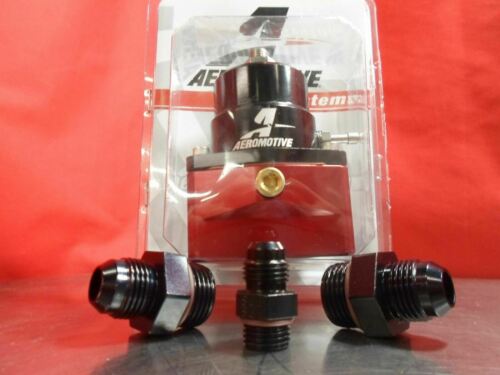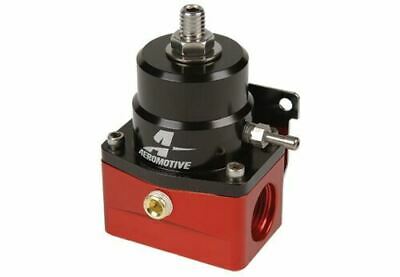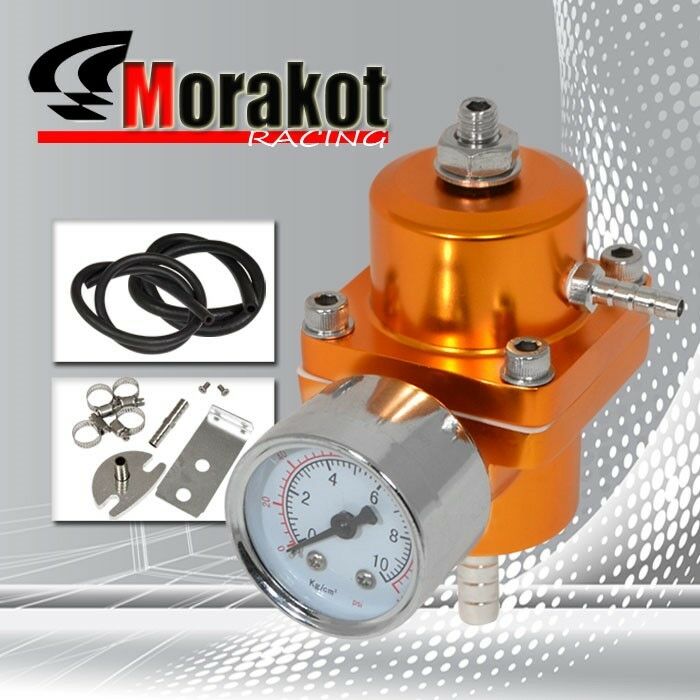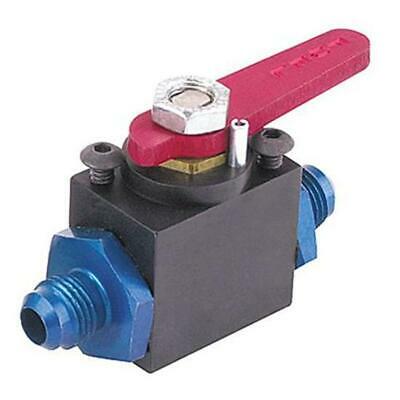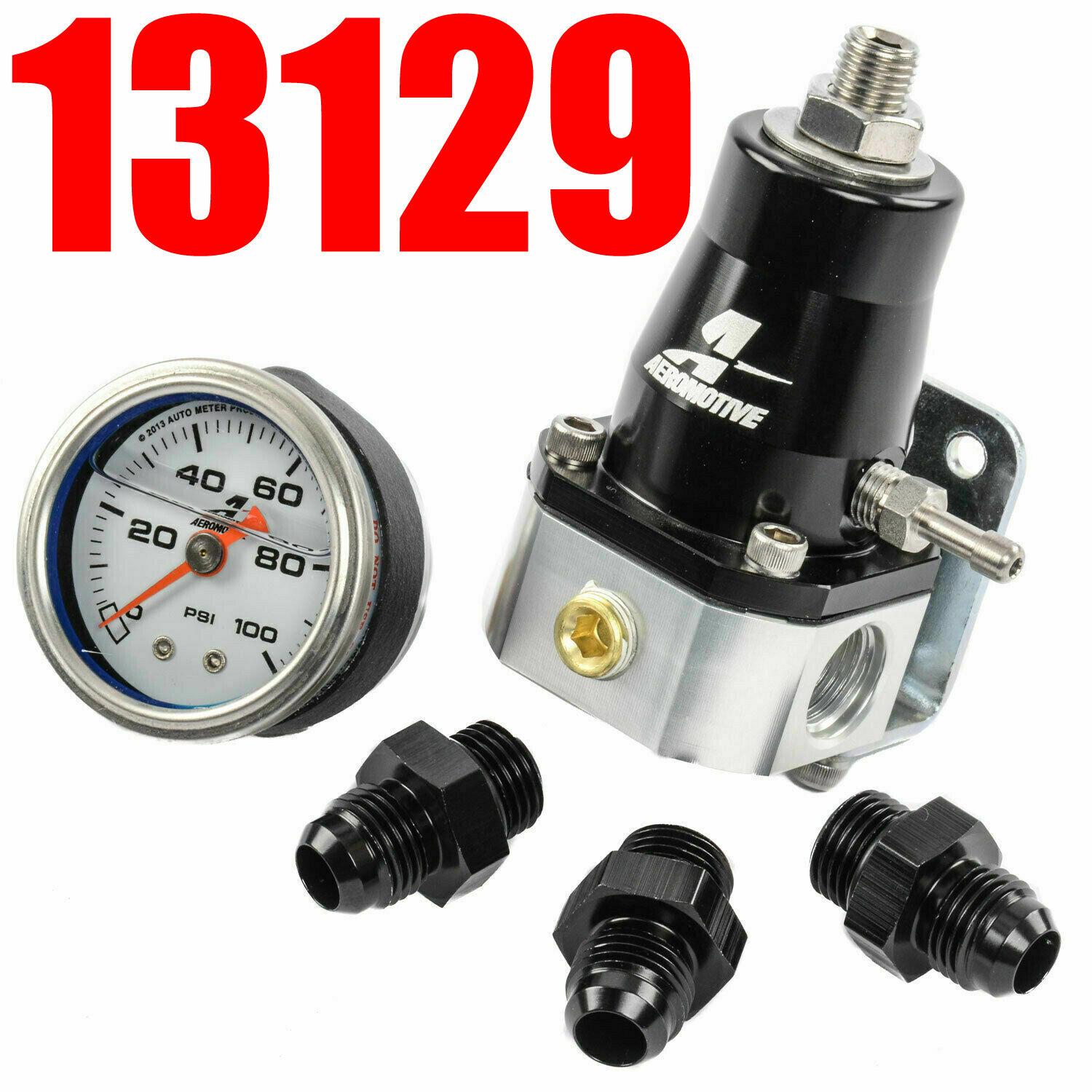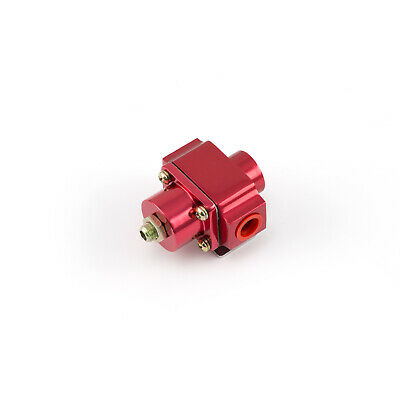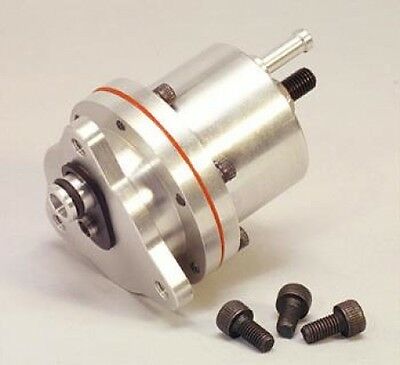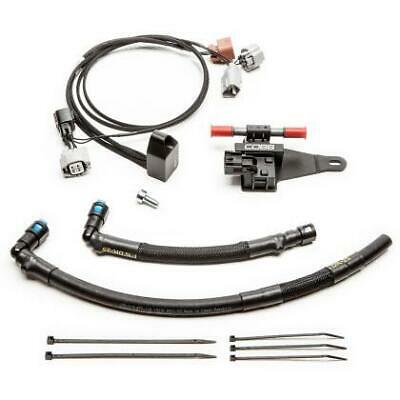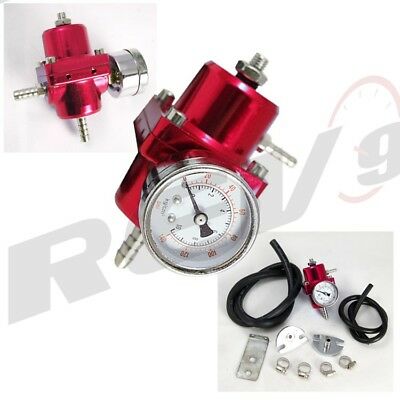-40%
Aeromotive Fuel Pressure Regulator 13101 A1000 EFI Regulator 8AN FEED FITTINGS
$ 117.13
- Description
- Size Guide
Description
MASTER WAREHOUSE DISTRIBUTOR for 100+ brandsPurchasing from an Alamo Autosports listing means you will receive factory warranty and support!
For questions regarding this, or any, product please contact us via eBay messenger.
(Monday- Friday 9:30AM-5:30PM CST)
Aeromotive Fuel Pressure Regulator 13101 A1000 EFI Regulator 8AN FEED FITTINGS
Alamo Autosports
An Authorized Master Dealer for AEROMOTIVE
Purchasing from an Alamo Autosports listing means you will receive factory warranty and support!
For questions regarding this product,
please contact us
via
eBay message service
(Mon-Fri: 9:30am – 5:30pm CST)
Aeromotive Fuel Pressure Regulator 13101 A1000 EFI Bypass Regulator
INCLUDES:
(1) AERMOTIVE regulator, (2) 10 ORB TO 8-AN FEED FITTINGS, (1) 6 ORB TO 6-AN RETURN FITTING
Part Number: 13101, 15610, 15606
This listing is for one (1) Aeromotive Fuel Pressure Regulator, AND FITTINGS
Aeromotive Part Info:
PerformanceEFI regulator designed for medium to high horsepower applications. Thisregulators features Aeromotive’s high-flow design, superb pressure control andlegendary durability. On the street and at the track, this pressure regulatorhas logged more miles, laps and passes than any other performance EFI regulatorin the world!
Base pressure adjustable from 40-75 PSI.
Gasoline and alcohol compatible.
Fuel pressure rises on a 1:1 ratio with boost.
1/8” NPT gauge port.
P/N 13101 provides (2) ORB-10 inlet ports and (1) ORB-06 return port.
FAQ - EFI Regulators
1.) After installing a larger (or secondary) fuel pump for my EFI engine, the fuel rail pressure went up and my regulator won’t adjust it back down, what’s wrong?
To understand this problem, it’s helpful to think of a fuel pump as “putting out flow” instead of “putting out pressure”. A bypass regulator restricts the flow, forcing pressure up before allowing fuel to return to the tank, creating fuel pressure and then maintaining it. If pressure won’t come down as the adjusting stud is turned out (counter-clockwise), the regulator may be too small to handle the pump’s flow rate, resulting in a false pressure. Also, check the return line for kinks or obstructions and make sure it’s not too small. Remember, during normal driving (idle and cruise), the regulator and return line together must flow over 99% of the pumps volume back to the tank, without building excessive back pressure.
If the return line or the regulator, or both, are too small for the pump, the resulting fuel pressure is said to be “false-high”. This means pressure is out of the regulator’s control until the return flow is reduced, like at high engine load (WOT), when there’s less fuel on the bypass.
This can cause the regulator to seem unable to be adjusted and it will create a pressure drop that looks like the pump is too small. Important: If the regulator will easily adjust 3-5 PSI lower than the desired base pressure, that’s a good indicator the regulator and return line are big enough to do the job
.
2.) Fuel is coming out of the vacuum/boost port on my regulator, why?
Fuel coming from the vacuum/boost port indicates the diaphragm has either been ruptured or delaminated (lost its coating) and fuel is passing through it. Regulator diaphragms may be damaged by service time, extreme pressures, chemical breakdown, or all of the above. In many cases the regulator may be repaired, older regulators may have to be replaced with a newer model.
Service kits that include replacement diaphragms are available for all
current
Aeromotive regulators.
Visit our website or contact the Aeromotive tech department if you need help finding a service kit.
3.) I’m trying to plumb an Aeromotive, stand-alone EFI regulator but don’t know where to put it, before or after the fuel rail(s), and which ports should go where?
Unlike a standard or “dead-head” carburetor regulator, which controls pressure between itself and the carburetor by stopping flow, the bypass regulator controls pressure between itself and the pump by bypassing flow. T
he optimum EFI regulator location is
after
the fuel rail(s)
when possible
. All pump flow, minus engine consumption, must always run to the regulator, wherever it is. Putting it after the fuel rail means all fuel must run through the fuel rail, and over the injector inlet, at all times. This ensures full flow is available to the injector in any instant. Most Aeromotive EFI regulators have two inlet ports, one on each side, and one bypass port, on the bottom. Either inlet may be used with a single fuel rail engine, both inlets with dual fuel rail engines. Any unused inlet ports must be blocked with the appropriate port plug. The ideal flow-path is: out of the fuel pump, into one end of the rail; out the other end of the rail, into the regulator side port(s); out the regulator bottom (return) port, back to the top of the tank. Dual rail applications should employ a Y-block to split the supply line before entering the rails, then individual lines are run from the opposite end of each rail into each inlet port on the regulator.
4.) I want to connect a wet nitrous kit to my EFI engine, can I use the 1/8″ NPT fuel pressure port on my Aeromotive regulator to supply the nitrous/fuel solenoid?
Feeding nitrous from a gauge port is generally discouraged.
The gauge port on most Aeromotive regulators is designed as a passage for sampling regulated pressure, and may not support adequate, regulated fuel flow for nitrous.
The typical bypass EFI fuel system can be tapped anywhere between the fuel pump outlet and regulator inlet. For best fuel pressure control to the nitrous fuel solenoid, connect the nitrous fuel supply line with a “T” inserted into one of the fuel lines coming out of the fuel rail, before it goes into the regulator. This “T” should be placed as close to the regulator inlet port as possible. To feed high HP nitrous systems, consider installing a dedicated fuel system to provide the fuel flow and pressure control needed for best, safe nitrous system performance.
5.) What is the barb fitting in the regulator cap used for? How and where should it be connected if I choose to use it, and what should I do with it if I don’t?
All Aeromotive, EFI bypass regulators incorporate the necessary design to allow the regulated fuel pressure to be vacuum/boost referenced on a 1:1 ratio with PSI. Always connect a vacuum/boost line between the intake manifold and the regulator cap for port fuel injected engines, forced induction or natural aspirated, where the fuel injector discharges into the intake manifold after the throttle body. Remember to set base fuel pressure with the vacuum/boost line disconnected from the regulator. For TBI engines or applications where the injector discharges above or before the throttle blade(s), the vacuum/boost port should be left disconnected and open to atmosphere, never blocked or plugged.
Note: the ratio of 1:1 is measured in PSI. When looking at a vacuum gauge, it is normally calibrated in “HG or inches of mercury. It takes roughly 2”HG to equal 1 PSI. So, for example, when the vacuum gauge reads 10”HG, with the engine at idle, fuel pressure will drop 1/2 of that or 5 PSI.
6.) I’ve installed my new Aeromotive bypass regulator. Fuel pressure seems to adjust fine and holds great when the engine is running, but when I shut the engine off, pressure drops quickly to zero. Shouldn’t the pressure hold like it did with a stock regulator?
No, Aeromotive EFI bypass regulators may not seal perfectly when the pump is off. They are engineered for the highest possible performance when the engine is running. OEM regulators must hold pressure for 30-minutes after shut-down to pass EPA emissions standards.
At Aeromotive we know our customers priority is to have the best possible flow and pressure control when the engine is running and we don’t compromise this standard to force the regulator to seal when the engine is off.
If extended crank or hard-start becomes a concern, first allow the pump to run and prime as long as possible after turning the key to the run position, then start cranking the engine, just before the pump shuts off. If the priming cycle is too short to allow the engine to start easily with this approach, extend the priming cycle in the ECU if programmable, or ad a timer board or momentary button to the fuel pump run circuit.
7.) My regulator doesn’t seem to keep consistent pressure, every time I look at the gauge it reads something different, it’s driving me crazy, what is the problem?
Chances are good you have a liquid filled fuel pressure gauge, infamous for changing its reading with temperature. Because a liquid filled gauge is sealed to keep the liquid inside, the pressure inside the gauge case may not be equal to atmospheric pressure. Once sealed shut, the liquid in the case expands and contracts as gauge temperature changes, making the internal pressure in the gauge vary up and down as it heats and cools. Case pressure can change as much as 7 psi up and down with heat, which affects the gauge mechanism and changes the gauge reading by the same amount!
Note: Even though the needle is moving up and down, fuel line pressure is NOT actually changing, the pressure in the gauge case just makes it look like it is.
Testing for this problem is easy, just carefully heat the gauge, using a heat gun or blow dryer, from cold to warm and then hot, while running the fuel pump. The gauge reading will drop as the oil inside warms up and the pressure in the gauge case increases. Now pop the plug in the side of the gauge case and watch the pressure drop back down.
Aeromotive now offers a brand new, state of the art, Liquid Filled Fuel Pressure Gauges for carbureted and EFI engines P/N’s 15632 and 15633 respectively.
These new “equalizer” gauges feature a pressure equalizing pin-valve in the side of the case allowing the user to compensate for heat related changes in case pressure, quickly restoring gauge accuracy at any operating temperature.
8.) I’m transplanting an EFI engine with a “returnless” fuel rail into a street-rod. The “returnless” fuel rail on the new engine has only one fuel line connection. Do I need a bypass regulator? How should it be plumbed? Can I mount the regulator back at the tank or should it be near the engine?
Yes, A bypass regulator with return line must still be used. Locating the regulator in the rear of the car is possible, but everything works better with the regulator as close to the fuel rail inlet as possible.
In order to use the “returnless” fuel rail(s) that came on the engine from the factory, the bypass regulator must be located before the fuel rail. Since the stock returnless rails have only one connection point (the inlet), an adapter fitting for AN line is required. Aeromotive offers a number of OEM to AN adapters to help with this.
The new bypass regulator should be located in the engine compartment, as close to the fuel rail inlet as possible, and the return line will be the full length of the car.
Aeromotive EFI regulators P/N 13101 and 13109 are popular for “returnless” engine transplants. Be careful using a factory style filter-regulator, like those used in the Corvette, if your fuel pump flows more than 250 LPH. The stock part is unable to handle the excess flow provided by high flow Aeromotive fuel pumps, causing false high pressure and reduced fuel pump service life. For high performance applications, most prefer to replace the stock “returnless” fuel rail with an Aeromotive Billet Fuel Rail.
9.) I have one of your bypass regulators, I don’t want to run a return line, can I plug the bypass?
No, you must run a return line of the appropriate size, from the bypass port all the way back to the fuel tank. Why? Bypass regulators work on the opposite principle of dead-head regulators. They are normally closed, meaning the flow into the regulator cannot flow onto the bypass until the set pressure is high enough to push the poppet up against the spring and open the bypass. Once open, excess flow is returned to the tank via the return line to prevent pressure from going any higher. Blocking the return port will spike pressure to the pump’s maximum, normally at or above 100 PSI.
Warning: The engine cannot run properly and the fuel pump may be permanently damaged if the regulator bypass port is blocked.
10.) I have one of your EFI bypass regulators that is advertised to adjust from 40-70 PSI. I have a turbo and need 60 PSI base fuel pressure. The turbo will make 20 PSI boost. With boost reference, total fuel pressure needs to be 80 PSI. Will pressure stop going up at 70 PSI?
No, the regulator will raise fuel pressure with boost on a 1:1 ratio, all the way to 80 PSI and beyond, if needed and if the pump will support it. There’s no real limit to boost reference as far as the regulator is concerned, but it’s important to understand that as fuel pressure goes higher, the flow from an electric fuel pump trends lower. If pump flow falls to a point where it’s no longer enough to support the engine, fuel pressure will stop rising (flatten) and then it will roll over and start falling as fuel demand continues to increase. This type of pressure drop is the result of inadequate pump/flow, it’s not a regulator issue.
11.) I need a fuel system that can run high base fuel pressure between 70-120 PSI continuous. What Aeromotive regulator can I use, and is there an electric pump you would recommend?
This is a question that arises from time to time, and the first answer is no. There is no single Aeromotive electric fuel pump that is currently suitable for continuous duty above 70 PSI. Notice I said no “single” fuel pump is suitable, We’ll expand on that in a moment. There are several Aeromotive EFI Bypass Regulators that will support adjusting base fuel pressure in this range, including P/N 13113 for between 50-90 PSI base, and P/N’s 13132, 13133 and 13134 with the 75-130 PSI high pressure spring installed.
The real question is what fuel pump can reliably support this high range of operating pressure while maintaining substantial fuel flow. With the exception of P/N 13134, all the regulators noted above are engineered for use with Aeromotive mechanical (belt or hex drive) fuel pumps. And, if operating pressure this high is required for a special application, the mechanical fuel pump is by far the best choice.
The downfall of driving a pump with an electric motor is that, as pressure goes up (the work load increases), the motor slows down. As the motor slows down the pump slows with it, resulting in less and less flow. Building a 12-volt electric motor capable of high RPM at high pressure is possible, but it would be so large and heavy, and draw so much current, that it would be impractical at best.
A mechanical pump on the other hand is small and light, and driven by the engine itself. Although the load placed on the engine is measurable, running a mechanical pump at high pressure draws less than 2-3 horsepower, nothing compared to the power it helps the engine produce. No way is a mechanical fuel pump going to slow the engine down as pressure increases. As a result, belt and hex drive fuel pumps can maintain high RPM at high pressure, making them perfect for high pressure, high flow applications.
So, is it possible to use electric pumps to operate at highly elevated pressures? Yes, but only if we’re talking about pumps (plural). This is a special application requiring two electric pumps of somewhat similar flow capacity, and that are plumbed into the system in an unconventional way. This plumbing approach is referred to as being “in series”. Of the two ways we can plumb multiple pumps into a single system, using pumps “in series” means one pump feeds the other, with the first pump drawing from the tank and feeding the inlet of the second pump. The other plumbing approach is called “in parallel”, where each pump has its own draw from the tank and the outlets are joined together to a single line that then feeds the engine.
The benefit of plumbing pumps “in series” is different than plumbing them “in parallel”. You could say two pumps “in parallel” will deliver twice the flow at any pressure, which can be very useful in systems with normal pressures that need substantial additional volume, but pumps in parallel at very high pressure, well zero times two is still zero. On the other hand, you could say two pumps in series can deliver the flow of a single pump but at twice the pressure. Plumbing pumps “in series” could then be viewed as a means of preserving flow, or offsetting the severe flow reduction caused by extreme pressure acting to slow the motor of a single pump down. In summary, there is limited gain running pumps in series in a system operating at normal pressure, but it can prove very valuable in applications requiring very high pressure.
The technical aspect of this involves knowing how to select pumps which, together, can get the job done, providing the needed flow at the pressure required. We must first know the flow volume required to support the engine. Then we need access to the flow curves for various pumps that may be combined “in series”. With this information we can select pumps that will be compatible. Finally, we have to understand how to predict what the chosen combination can flow at the pressure desired. The following method may be used to approximate the flow available from two pumps, “in series”, at a specific pressure:
To find the flow volume available from two pumps plumbed “in series”, at a desired pressure, find the point on each pump’s flow curve where their volume is equal. Note the pressure at which this occurs for each pump and add that together. The sum of these two pressures equals the higher pressure at which the matched flow of either pump is available from the pair, plumbed in series.
Working with two pumps of equal size is both desirable, and easy to project performance. For example, combining two A1000 fuel pumps “in series” you know that they will flow the same at any pressure. To determine flow at any pressure simply requires dividing the desired
high
pressure in half and looking at the A1000 flow curve for flow at that pressure. The two pumps in series will produce the flow of one A1000 at half the pressure. If the target pressure were 120 PSI, half of that is 60 PSI. The A1000 flow curve shows 766 lb/hr at 60 PSI from one pump. What would this combination support at 120 PSI? Using a forced induction BSFC of 0.65, we divide the flow at 766 lb/hr by 0.65 to find a maximum of 1,178 flywheel horsepower is possible. It would be safe to say that one A1000 pump will support 1,000 FWHP at 60 PSI and two A1000 fuel pumps, plumbed “in series” would support 1,000 FWHP at 120 PSI.
Note: Combining pumps that have substantially different flow curves is a recipe for problems. For example, thinking you could feed an A1000 with a stock fuel pump in the tank would be a mistake. If two pumps in series are not going to have the same flow rates, a differential of no more than 10-20% flow at the same pressure, between the two pumps, is likely to be practicable.
Don’t see what you want? Contact us about getting a combo or custom listing for any of the hundreds of manufacturers we carry.
If you are unsure about fitment, applications, technical specifications, or any other questions, please contact us via
eBay message service
before buying.
SERIOUS BIDDERS ONLY
Our Company
Alamo Autosports opened in 1992 and specializes in Japanese and European import vehicles. We are a full service performance shop located in the Dallas/Fort Worth Metroplex. We carry over 250 OEM and aftermarket performance product lines, as well as custom fabrication CNC work, tuning, and all of your performance needs .
Services and products we offer:
complete performance engine builds
in house 2WD and AWD Dynos (rolling road)
engine management and tuning
complete fuel system fabrication
performance bolt-on parts
racing radiators and cooling
performance brake upgrades
performance suspension parts
performance exhaust systems
performance drivetrain parts
fabrication and welding
complete turbo kits
CNC Darton block sleeving
Payment
Returns
"Buy it now” items are to be paid in immediately. Payment must be received in full within 3 business days. All auctions not paid for within 3 days will be reported to eBay for request of the final value fee credit.
PayPal
We accept domestic and international PayPal payments
All major credit cards accepted through PayPal.
Sales Tax
Texas residents will be charged state sales tax.
Contact us before returning any items. Returns will be considered on a case-by-case basis. No returns on special order parts. The item must be returned in its original condition and in the original manufacturer’s packaging. Wheels that had tires mounted cannot be returned. Buyer is responsible for return postage.
20% RESTOCKING FEE
Return Shipping Address
Alamo Autosports
Attn: eBay Department
1218 Colorado Ln Suite C3
Arlington, TX 76015
Shipping
Orders are shipped directly from our location or from the manufacturer/ warehouse location. Pick-up and Will Call is available upon request. Tracking number will be updated in PayPal and eBay when shipped. We will only ship to confirmed PayPal addresses.
Delivery
It is your responsibility to accept delivery in person and inspect the package before accepting delivery. Please make sure to open the box immediately when taking delivery, to avoid potential issues. Do not sign for any damaged package and report it to driver immediately.
Shipping Carriers
All items are shipped via:
UPS
UPS Supply Chain Solutions
USPS
Domestic Shipping
Most items ship within 1-2 business days
Contiguous 48 - All shipments are via UPS
Hawaii, Alaska, Puerto Rico, other US Territories
Additional cost for shipping, please contact us via
eBay message service
for shipping prices
UPS and USPS shipping available
Military and PO Boxes
We ship to Military (APO, etc.) and PO Box addresses
USPS only
International Shipping
Most international orders ship within 3-5 business days
All international shipments require a valid phone number and email address before shipping
Buyers are responsible for all import duties and brokerage fees
UPS and USPS shipping available
Freight
Please contact us via
eBay message service
for this shipping option.
Messages
Inventory
Please allow 1-2 business days for responses. We receive hundreds of messages a day and we answer them as quickly as possible.
All products are in stock when listed on eBay. If you need the product ASAP, MESSAGE US via
eBay message service
before bidding.
Business Hours
Monday – Friday
9:30AM – 6:30PM
Central Standard Time Zone (GMT -06:00)
Daylight Savings Time
Closed Saturday and Sunday
Contact Information
eBay message service
For combined shipping or custom needs or requests contact us at the shop.
Payment
Shipping
Returns
Payment
Shipping
Returns
"Buy it Now"
items are to be paid for immediately. Payment must be received in full within three business days. All auctions not paid for within three days will be reported to eBay for request of the final value fee credit.
PayPal
We accept domestic and international PayPal payments.
All major credit cards accepted through PayPal.
Sales Tax
Texas residents will be charged sales tax.
Orders are shipped directly from our location or from the manufacturer/ warehouse location. Pick-up and will call are available upon request. Tracking number will be updated in PayPal and eBay when shipped. We will only ship to a PayPal confirmed address.
Delivery
It is your responsibility to inspect the package before accepting delivery in person. To avoid potential issues open the package upon delivery. Do not sign for any damaged package and report it to the driver immediately.
Shipping Carriers
All items are shipped via:
USPS
UPS
UPS supply chain solutions
Domestic Shipping
Most items ship within 1-2 business days.
Contiguous 48- all shipments via USPS or UPS.
Hawaii, Alaska, Puerto Rico and other US territories have additional cost for shipping. Please contact us by eBay message service for shipping prices. USPS and UPS shipping available.
Military and PO Boxes
We ship to Military (APO, etc) and PO Box addresses. USPS only.
International Shipping
Most international orders ship within 3-5 business days.
All international orders require a valid phone number and email address before shipping.
Buyers are responsible for all import duties and brokerage fees.
We will not ship items as Gifts.
USPS and UPS shipping available.
Freight Shipping
Please contact us via eBay message service for this option.
Contact us before returning any items.
Returns will be considered on a case-by-case basis. No returns on special order parts. The item must be returned in its original condition and in the original manufacturer's packaging. Wheels that had tires mounted cannot be returned. Buyer is responsible for return postage.
20% RESTOCKING FEE
Return Shipping Address
Alamo Autosports
Attn: EBay Department
1218 Colorado Ln Suite C3
Arlington, TX 76015
Add a map to your own listings. FREE Trial!

